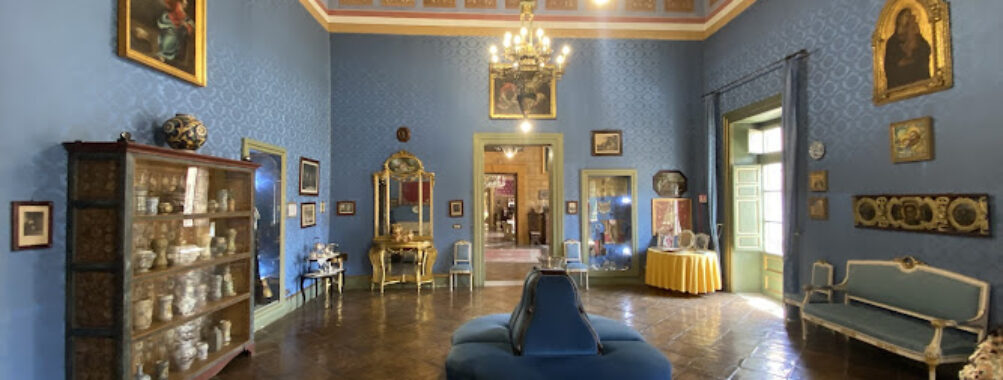
Count Federico Palace – Museum
Table of Contents
Description
Count Federico Palace – or Palazzo Conte Federico if you want to sound like a local – is one of those rare places where history doesn’t just sit behind a velvet rope. It breathes. Built in the 17th century around an Arab-Norman tower dating back to the 1100s, the palace is a living museum that still doubles as a family home. That’s right, the Federico family still lives here, and they’re the ones who guide visitors through the halls. It’s not every day you get shown around a centuries-old palace by the descendants of Emperor Frederick II himself. There’s a warmth and intimacy to the experience that feels very different from a typical museum tour.
Inside, you’ll find grand salons with frescoed ceilings that make you crane your neck in wonder, antique weapons collections that look like they belong in a medieval saga, and carefully preserved ceramics that tell a quieter story of daily Sicilian life. The atmosphere is less “sterile museum” and more “stepping into someone’s home where the walls have seen a thousand stories.” Of course, not every visitor falls head over heels. Some feel the tour moves too quickly or that the content leans heavily on family anecdotes. But honestly, that’s the charm for many—it’s personal, quirky, and refreshingly human.
What struck me most when I visited was how the palace blends layers of history like a cake: Punic foundations, Arab-Norman tower, Baroque flourishes, and then, right in the middle of it all, the modern family dog wandering through the courtyard as if this were the most normal thing in the world. That juxtaposition makes the palace feel alive, not frozen in time. If you’re the kind of traveler who craves authenticity and doesn’t mind a little imperfection, this place will probably stay with you long after you leave Palermo.
Key Features
- One of the oldest palaces in Palermo, built around a 12th-century Arab-Norman tower
- Guided tours led by the Federico family themselves
- Lavish ballrooms with original frescoes and antique furnishings
- Collections of medieval weapons, armor, and ceramics
- Remnants of the ancient Punic city walls integrated into the structure
- Atmosphere of a lived-in home rather than a conventional museum
- Child-friendly environment with plenty of visual interest for younger visitors
- Basic amenities available, including restrooms and Wi-Fi
Best Time to Visit
If you want the palace almost to yourself, go in the morning. The tours usually start around 11 a.m., and the earlier slots tend to be quieter. Midday can get busier, especially during summer when cruise ship groups roll into town. Palermo in July and August can be brutally hot, and while the palace walls keep things cooler than outside, you’ll still feel the heat. Spring and autumn are ideal—pleasant weather, fewer crowds, and better light for photos. Personally, I went in late October, and it was perfect: golden light streaming into the courtyard, cool enough to walk around comfortably, and just a handful of other visitors.
If you’re the type who likes to pair sightseeing with food (who isn’t?), consider timing your visit before lunch. The palace is in Palermo’s historic center, so you can easily wander out afterwards and grab a plate of pasta con le sarde or some street food like arancine. Trust me, nothing makes history more digestible than following it up with Sicilian snacks.
How to Get There
The palace is right in the historic heart of Palermo, which makes it easy to reach on foot if you’re already exploring the old city. Most of the major landmarks—like the Cathedral and Quattro Canti—are within a 10–15 minute walk. If you’re coming from further out, local buses and taxis will drop you nearby, but honestly, walking is the best way. Palermo’s streets are a maze of narrow alleys, hidden piazzas, and unexpected little churches, so half the fun is getting a bit lost along the way. Just wear good shoes; cobblestones and sandals don’t always mix well.
For those driving, parking in the historic center is notoriously tricky. I wouldn’t recommend it unless you enjoy the stress of circling tiny streets while scooters zip around you. Public transport or simply strolling in is a much more relaxed option.
Tips for Visiting
First and foremost, remember that this is still someone’s home. Be respectful, don’t wander off during the tour, and keep your voice down if you’re in a large group. Tours are offered daily except Wednesdays, and they run at set times (usually on the hour from late morning through early afternoon). You don’t need to book far in advance, but showing up a few minutes early is smart.
Accessibility is limited—there’s no wheelchair access, and the staircases are steep in places. Families with young kids will find it manageable though, and children often love the armor and old weapons on display. The palace does have restrooms and Wi-Fi, but don’t expect a café or restaurant inside. Bring a bottle of water, especially in the warmer months.
One more thing: let yourself enjoy the imperfections. The tour isn’t polished like a big museum audio guide, and that’s what makes it special. You’ll hear family stories, see personal touches, and maybe even meet the count himself. And if you’re lucky, you’ll get one of those little moments—like when I spotted the family cat perched on a 400-year-old chair—that remind you history isn’t just in the past, it’s still happening right here.
Location
Places to Stay Near Count Federico Palace - Museum
Find and Book a Tour
Explore More Travel Guides
No reviews found! Be the first to review!